There are John Foster’s in every county of every state throughout all of American history. In fact in most counties at any given time you will find multiple John Fosters. So while I am grateful to late cousin Barbra Bandy Jones of Oklahoma for first telling me that we descend from a John Foster born about 1752, it seemed that with such a common name, there was very little hope of learning more. I must thank cousin Robert Ivey of South Carolina for his research work on the families around Grindal Shoals, Union County, South Carolina for making the connection with ‘my John Foster’ that helps differentiate him all the others. Through his work, we know his wife’s name and through his wife, we know how he was connected to his neighbours along the Pacolet River. And through these connections will come any possibility of tracing this line of Fosters back further.
Robert Ivey shared with me the contents of a letter written in 1786 by John Jasper Jr. of Augusta Co. Virginia to his parents in South Carolina. In it he gives the news, he sends some money with instructions on some family business and asks to be remembered to his brothers and sisters and to all their husbands and wives and to John Foster and Molley. “Molley” it develops, is Mary McElfresh Foster, the sister of Susannah McElfresh Jasper, the letter writter’s own wife. When one understands the Jasper family one realizes that many of the neighbours living along the stretch of the Pacolet River in that part of Union County (and later Cherokee County) South Carolina, are there because of their Jasper family contacts. See Jasper Jamily, McElfresh Family, Hames Family.
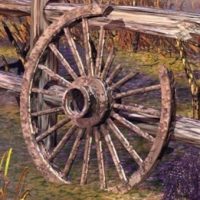
Marriage records find Susannah “Sukie” McElfresh married John Jasper Jr. in Hagerstown Maryland. It turns out the McElfresh family (often spelled MacElfish and other variations in early documents) was well established in Maryland and so I began to wonder if the John Foster that married Sukie McElfresh’s sister and so became a brother in law to the Jasper clan might also have come from Maryland. Internet searches and a visit to the Washington County Archives in 2018 revealed this tantalizing artifact.
A 1777 muster roll from Captain Jacob Sarer’s Washington County Militia. Counties throughout the colonies were organizing to fight the British and the men of Washington County Maryland were no exception. It was interesting to find a John Foster listed, although John Fosters are so common it didn’t mean anything of great significance. The excitement 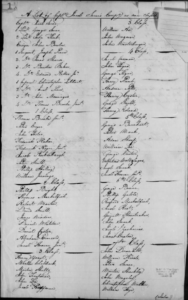 happened upon discovering there are two men named McElfresh enlisted in the same company. This feels like it could well be my John Foster. Washington County is in the western part of Maryland, and in 1777 was just newly carved out of Frederick County so more genealogical research will have to be done there. To make matters more convoluted this border area was first thought to be in York County Pennsylvania. So there are a few directions that will need more chasing up.
happened upon discovering there are two men named McElfresh enlisted in the same company. This feels like it could well be my John Foster. Washington County is in the western part of Maryland, and in 1777 was just newly carved out of Frederick County so more genealogical research will have to be done there. To make matters more convoluted this border area was first thought to be in York County Pennsylvania. So there are a few directions that will need more chasing up.
The earliest South Carolina record we have of the John Foster known to be ‘our’ John Foster is a lease and release land transaction. It was found in a book of such document abstracts by Brent Holcomb. Who I was lucky enough to meet on my first trip to South Carolina in 2009. His volumes are HIGHLY recommended. The record contains many interesting details.
It is dated May 1785 and identifies the parties as John Portman of Ninty Six District and John Foster of same. This document predates the formation of Union District and Union County when Ninety Six District was almost the entire upcountry portion of South Carolina. The transaction is in Sterling indicating American money was not yet in circulation. It locates the parcel of land as being 200 acres on both sides of Little Sanday (sic) Run, a branch of the Pacolet River. It contains a pioneer’s cabin (Hugh Pelms cabban). It goes on to describe the land as being part of an original land grant to John Kerconnel by the Royal Governor of the province of North Carolina. The area is at the border between North and South Carolina and thought by all to be part of North Carolina as native Indians were still attacking survey teams in the hill regions.
The transactions is witnessed by kinsmen. Daniel Covenhoven and Nicholas Jasper, a member of that same Jasper family mentioned earlier. In fact this piece of land is part of the parcel of land that brought the Jaspers and so many connected families to this area. Once again I must express gratitude to Robert Ivey from Grindal Shoals Gazette;
“The key factor in the first removal to what later became South Carolina, was John McWhorter’s marriage to Mary Jasper. After John’s father, John, Sr., died in 1757, his mother, Eleanor, applied for and received a grant of 300 acres on September 26, 1766, from Mecklenburg County, North Carolina. The land was on both sides of Pacolet River. The McWhorters were from Albemarle County, Virginia
A part of the Jasper family settled on Eleanor Brevard McWhorter’s land, and a part on John Portman Sr. and Jr.’s land. John Portman Jr. married John McWhorter Jr.’s sister, Sarah. The Portman lands were also granted in the 1760s.”
So the land John Foster is acquiring by ‘lease and release’ a form of rent to own, is the land he has probably been squatting on as part of this family group.
Exactly when John Foster and his family arrived along the Pacolet is unknown. They could have lived as squatters for many years before the 1785 lease and release land purchase. Cousins Robert Ivey and Barbra Anderson late of Joplin Missouri contend that a John Foster said to have served with various South Carolina Militia was ours. The records show service in South Carolina beginning in 1779 and the war ended in 1783. Was this our John Foster? Certainly, our John was welcomed by the family and fellowship of neighbours who had fought the Patriot fight in South Carolina. It becomes clear that neighbour James Moseley, a genuine folk hero, and also a veteran of South Carolina Militia was a close friend and eventually relative through marriage. The Maryland Militia seems to have had a reputation for infighting and politics rather than a record of success against the British. Perhaps luckily no battles were ever fought in Maryland. Additional records or references relating to Captain Sarer and his regiment or John Foster have been hard to find, so just maybe by 1779 he has relocated to the region of the Pacolet.
Roster of South Carolina Patriots in the American Revolution Vol I by the late Bobby Gilmer Moss, whom I met on my first trip to South Carolina in 2007, by the introduction of Miss Ola Jean Kelly at Union County Museum lists his service in considerable detail. Of interest is that militia service was much more hectic in South Carolina where several key battles were fought against the British and in fact several events took place right at or very near Grindal Shoals. Yet the terms of service were short allowing citizen-soldiers to mind their farms and families and were called on only when the need arose. More details about the Revolution in this region and the actions of Generals Thomas Sumter, Daniel Morgan and British Col. Banastre Tarlton can be found HERE.
ohn Foster bought land from Nicholas Jasper in 1783.
“Memorandum of a bargain and agreement made between Nicholas Jasper of the state of Kentucky of the one part and John Foster of the state of South Carolina and Union County of the other part that is to say the said Jasper hath bargained and sold unto the said Foster a certain tract or parcel of land in Union County on Pacolate river containing two hundred and ninety-three acres by estimate. The same more more less begins as follows at a pine knot corner belonging to John Jasper Sr. thence to Charles Hames Sr.’s pine corner thence with said line to Nicholas Jaspers corner on the river thence to a hickory corner thence to a pine corner thence to said Jasper sr. corner at the river thence with said line to a poplar standing in the branch above said Jasper Sr’s house thence to a ______ _____ thence to the said pine knot corner.
The said John Foster covenants and agrees to pay five hundred dollars on the tenth day of March which shall be in the year one thousand eight hundred. …”
So, in about the same year that son Jarrett (Garrett) is born, John Foster buys land along the Pacolet from his wife’s brother in law that is nestled in a community of kin including John Jasper Sr. and Charles Hames.
Can anyone place this on a map?
John Foster’s neighnourhood as it was recorded in the first ever Federal Census 1790. The census was decreed in the brand new Constitution of the United States after independance was won from Britain as the means of determining how many seats in the new House of Representatives would be allowed for each state. Representation by population, as opposed to two seats per state regardless of population in the Senate. Checks and balances were a trademark of the new American experiment in democracy.
The cenus taker would have travelled established roads and paths as he made his way through the region in which John Foster now resided. So the names become interesting.
The flow of names makes me think the census take was tracing a path along the Pacolate from West to East. The first name I recognize is Hodge and I have visited the Hodge Cemetary west of the modern bridge. Then we find Stribling, a family that my late cousin Barbra Anderson told me ad served with Brandon in the Revolution and whose ancestors of kin that married into our family later in Tennessee or Missouri . We find Gault. John’s daughter Mary married into the Gault family. Then McWhorter whose famiy was the cause of the Jasper clan coming to South Carolina in the first place, Then Crowenocer which is a kin family – but I need to be reminded how. Then another McWhorter and a couple of Maybrys who is a kin family too and who eventually gave John Foster a loan. Then Backster Moseley, son of James Moseely. Then John Henderson. The Hendersons were well-to-do (20 slaves) and were instrumental in the development of the state of Kentucky. Then John Jasper whose land ajoined John Foster, then John himself.
His household consists of:
- 1 Free white male age 16 years and upward.
3 Free white males under 16 years.
6 Free white females
0 Other free persons and
0 Slaves
Then continuing generally westward, kinsmen, friend and neighbor, James Moseley, John and William Hames, another McWhorter, a couple of Bobos which became a kin family, later on, some Colemans, Another Hames, John Jasper, then Fowlers a kin family, later on, More McWhorters, Nicholas Jasper who must have maintained property in Union Co. as well as Kentucky. And by now we must be all the way along modern Tump Smith Road and into the Pea Ridge district.
in the 1800 Federal Census. The population of Union County has grown by 33% from the 1790 total to 10,237. So on average for every one neighbour in 1790, now there are now three. Familiar names remain and some new ones pop up. There is another John Foster in the space of three pages of recorded names. Plus a George and Kenny Foster, no relation that I can determine so far. James Pickens is in the area and two of John Foster’s sons will marry Pickens girls as will an elderly James Moseley. Also nearby now, is two households of Prigmores. The name shows up 160 years later when Andrew J. Foster, in describing the family’s move from pro-Confederate Jasper County MO. to pro-Union Bourbon Co. Kansas describes how they stayed with “uncle Johnny Prigmore. A coincidence? Maybe.
John’s household is recorded as:
Free Males <10 years: 2
Free Males 10-15 years: 2
Free Males 16-25 years: 1
Free Males 26-44 years: 0
Free Males 45 years+: 1
Free Females <10 years: 1
Free Females 10-15 years: 1
Free Females16-25 years: 1
Free Females 26-44 years: 1
Free Females 45 years +: 0
Slaves: 0
In 1803, John sells his original land to James Maybry. Recorded at the county courthouse in August of 1805, it reads:
“Know all men by these presents that I John Foster of Union District and the State of South Carolina am held and firmly bound unto James Maybry in the sum of twelve hundred dollars to be paid to the said James Maybry his certain attorney, executors administrators or ___ to which payment well and truly to be made. I bind myself, my heirs, executors and administrators jointly and severally sealed with my seal and dated this 16th December 1803. The condition of the above obligation is such that if the above John Foster shall and doth on or before the 25th December 1803 well and truly make or cause to be made to the said James Maybry a good and lawful right and title to a certain tract of land containing two hundred acres more or less on both sides of Sandy Run beginning at a white oak on the north side of the Rocky Branch of said run thence at 180 poles to a hickory West 180 poles _____ said run ___white oak thence 180 poles to hickory thence 180 poles to the beginning then this obligation to be void and of none effect. Otherwise to remain in full force of ___ and virtue.”
I’d love to know why it was structured this way but it looks like John was paid for the land in advance of actually turning over the deed. Or maybe it took from the 16th to the 25th to have the deed properly registered? A curious document.
T Settlement of the estate of John Foster, deceased. The inventory and sale notes are dated February 1st 1936.
The following year his sons Frederick and Jarrett appears in East Tennessee. So the death of their father presents the opportunity perhaps through the sale of their father’s lands, to move west.
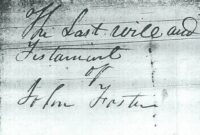

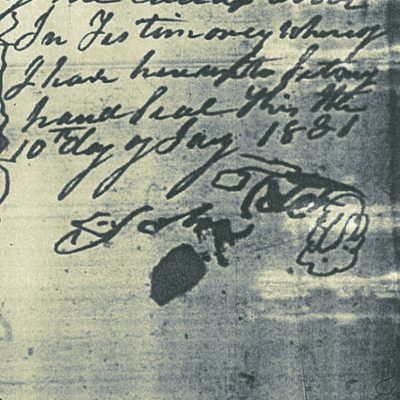
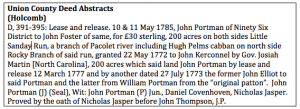
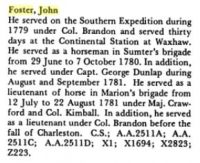
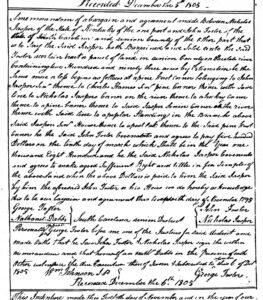
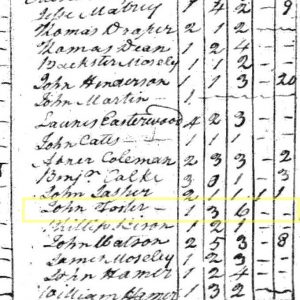
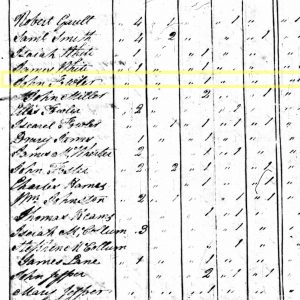
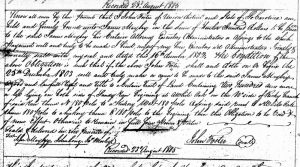
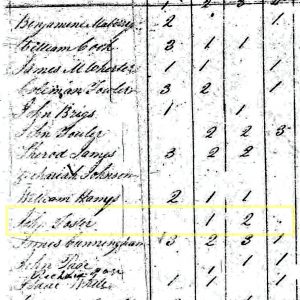
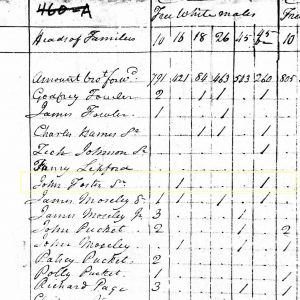
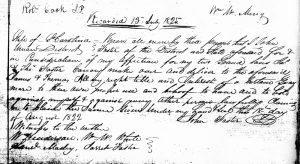
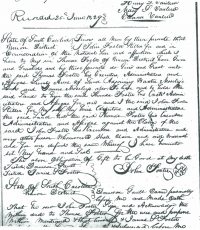
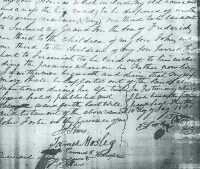
Leave A Comment
You must be logged in to post a comment.